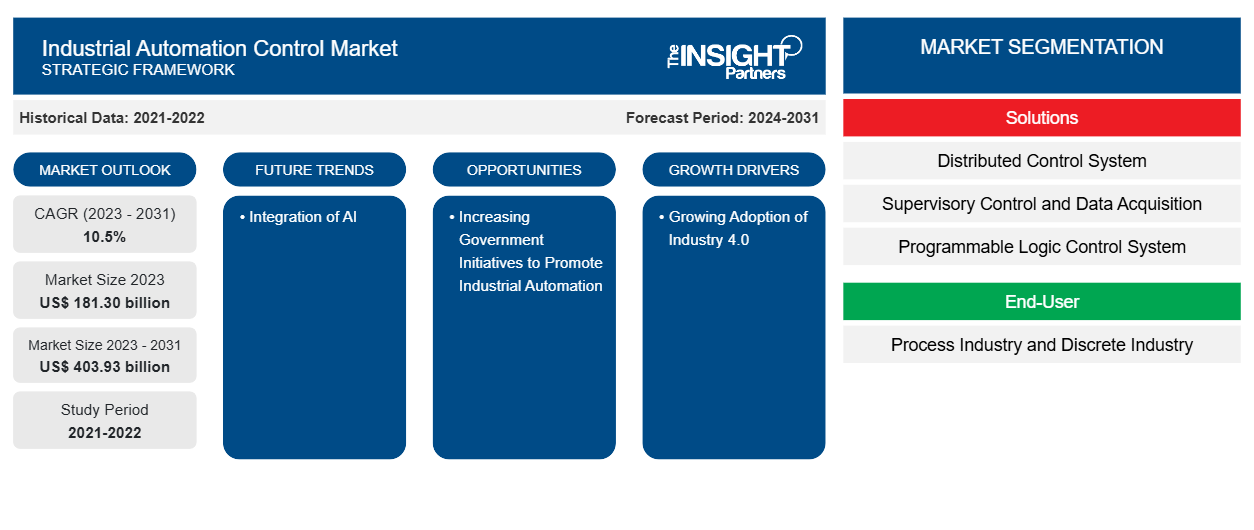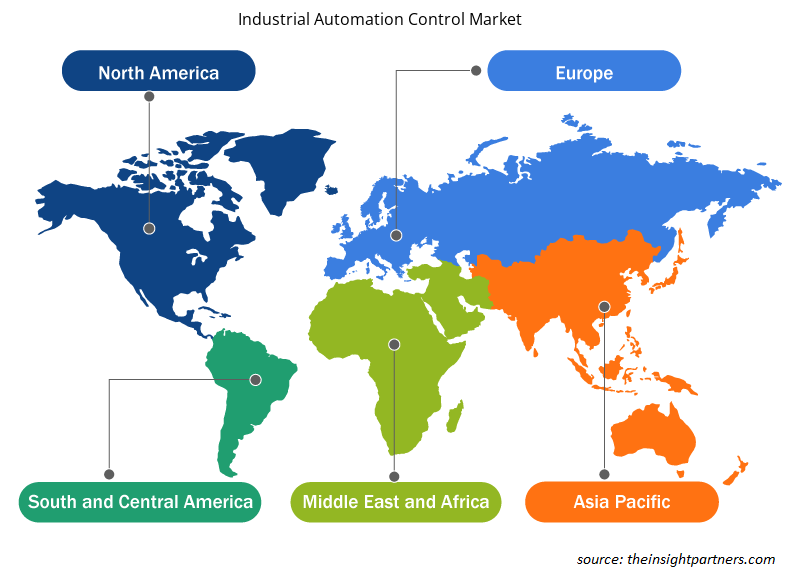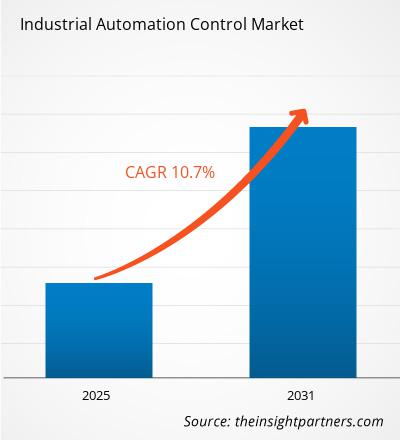Der Markt für industrielle Automatisierungssteuerungen wird voraussichtlich von 193,22 Milliarden US-Dollar im Jahr 2024 auf 391,63 Milliarden US-Dollar im Jahr 2031 anwachsen. Für den Zeitraum 2025–2031 wird eine durchschnittliche jährliche Wachstumsrate (CAGR) von 10,7 % erwartet. Die Integration von künstlicher Intelligenz (KI) und maschinellem Lernen (ML) dürfte in den kommenden Jahren neue Trends auf den Markt bringen.
Marktanalyse für industrielle Automatisierungssteuerung
Die Automatisierung in der Fertigung umfasst ein breites Anwendungsspektrum, von der Steuerung von Fließbändern und Verpackungsprozessen bis hin zur Überwachung komplexer Aufgaben wie der Präzisionsbearbeitung oder der chemischen Produktion. Durch Echtzeit-Datenerfassung und -analyse können automatisierte Systeme Fehler erkennen, Wartungsbedarf prognostizieren und Arbeitsabläufe optimieren, was zu weniger Ausfällen und Ausfallzeiten führt. Dies führt zu einer agileren Produktionsumgebung, die schnell auf Marktveränderungen oder die Verbrauchernachfrage reagieren kann. Durch die Reduzierung menschlicher Fehler und eine verbesserte Betriebskontrolle trägt die industrielle Automatisierungssteuerung zudem entscheidend zur Verbesserung der Arbeitssicherheit bei. Für Unternehmen bedeutet dies erhebliche Kosteneinsparungen, schnellere Produktionszyklen und eine effektivere Skalierung der Betriebsabläufe. Durch die zunehmende Nutzung von Automatisierungstechnologien können Branchen ihre Wettbewerbsfähigkeit und Innovation steigern und sich so für langfristiges Wachstum und Erfolg in einem zunehmend digitalen und globalisierten Markt positionieren.
Marktübersicht für industrielle Automatisierungssteuerung
Industrielle Automatisierungssteuerung bezeichnet den Einsatz fortschrittlicher Technologien und Steuerungssysteme wie Computer, Roboter und Informationssysteme zur Verwaltung und Überwachung industrieller Prozesse und Maschinen. Ziel der industriellen Automatisierungssteuerung ist die Verbesserung von Effizienz, Produktivität und Sicherheit durch die Reduzierung menschlicher Eingriffe in Fertigungsabläufe. In Unternehmen rationalisiert die industrielle Automatisierungssteuerung die Produktion durch die Automatisierung repetitiver und zeitaufwändiger Aufgaben und ermöglicht so schnellere, präzisere und konsistentere Ergebnisse. Durch Automatisierung können Unternehmen die Betriebseffizienz steigern, das Fehlerrisiko reduzieren und die Arbeitskosten minimieren – und das bei gleichbleibend hoher Produktqualität. Diese Systeme integrieren häufig Sensoren, Roboter und künstliche Intelligenz (KI), um Produktionslinien in Echtzeit zu überwachen und zu steuern und Anpassungen vorzunehmen, um die Leistung zu verbessern und Abfall zu reduzieren.
Passen Sie diesen Bericht Ihren Anforderungen an
Sie erhalten kostenlos Anpassungen an jedem Bericht, einschließlich Teilen dieses Berichts oder einer Analyse auf Länderebene, eines Excel-Datenpakets sowie tolle Angebote und Rabatte für Start-ups und Universitäten
Markt für industrielle Automatisierungssteuerung: Strategische Einblicke

-
Informieren Sie sich über die wichtigsten Markttrends in diesem Bericht.Dieses KOSTENLOSE Beispiel umfasst Datenanalysen, von Markttrends bis hin zu Schätzungen und Prognosen.
Treiber und Chancen auf dem Markt für industrielle Automatisierungssteuerung
Weit verbreitete Einführung industrieller Automatisierungssteuerung in verschiedenen Branchen
Die industrielle Automatisierungssteuerung nimmt auch in anderen Branchen als der Automobilindustrie zu. In der jüngeren Vergangenheit waren die Nicht-Automobilindustrien im Vergleich zur Automobilindustrie deutlich unterrepräsentiert. Mit der zunehmenden Funktionalität von Anlagen wie Industrierobotern ist zu erwarten, dass die Nicht-Automobilindustrie die Einführung industrieller Automatisierungssteuerungen weiter beschleunigen wird.underpenetrated in comparison to the automotive industry. With the increasing functionality of equipment such as industrial
Neben den Branchen nimmt die Marktdurchdringung auch in anderen Ländern zu. Industrieländer wie China, die USA und Japan weisen eine höhere Marktdurchdringung auf; dennoch besteht auch in den Industrieländern noch viel Potenzial für weiteres Wachstum. So entfielen im Jahr 2023 35 % der Bruttoproduktion auf China, was fast dem Dreifachen der Bruttoproduktion der USA entspricht. China liegt mit 12 % an zweiter Stelle. Die Aussicht auf weitere Installationen ist in vielen dieser Länder bemerkenswert, insbesondere in der Nicht-Automobilindustrie. Dieses Wachstum ist auf die notwendige Modernisierung und Transformation dieser Märkte zurückzuführen. Diese Statistiken sind vielversprechend für Hersteller, da sie enormes Potenzial für eine weitere Steigerung der Akzeptanz verdeutlichen.
Anstieg der staatlichen Unterstützung
Die Bedeutung von Regierung und Politik bei der Förderung der industriellen Automatisierungssteuerung hat deutlich zugenommen, da Industrien weltweit nach Effizienzsteigerungen und optimierten Fertigungsprozessen streben. Da die industrielle Automatisierungssteuerung eine zentrale Rolle in der vierten industriellen Revolution spielt, müssen Regierungen und Politik geeignete Fördermechanismen und regulatorische Rahmenbedingungen schaffen, um ihre breite Akzeptanz und ihr Wachstum zu fördern. In Indien beispielsweise hat die Regierung verschiedene Maßnahmen zur Stärkung des Smart-Manufacturing-Sektors umgesetzt, darunter das Production Linked Incentive (PLI)-Programm. Das 2020 eingeführte PLI-Programm zielt auf 14 Branchen ab, darunter Automobil-, Pharma-, Textil-, Lebensmittel- und Haushaltsgeräteindustrie, und ist Teil einer umfassenderen Strategie zur Förderung der inländischen Produktion. Das Programm soll Unternehmen zur Einführung intelligenter Fertigungsverfahren ermutigen, indem es Unternehmen, die lokal produzieren und bestimmte Investitions-, Verkaufs- und Exportkriterien erfüllen, finanzielle Anreize bietet. Diese Initiative zielt darauf ab, die Wettbewerbsfähigkeit dieser Unternehmen zu steigern und so den Gesamtwert des indischen Fertigungssektors zu erhöhen.PLI) scheme. Launched in 2020, the PLI scheme targets 14 sectors, including automobiles, pharmaceuticals, textiles, food processing, and white goods, as part of a broader strategy to promote domestic manufacturing. The scheme is designed to encourage companies to adopt smart manufacturing practices by offering financial incentives to those that produce goods locally and meet specific investment, sales, and export criteria. This initiative aims to enhance the competitiveness of these companies and, in turn, elevate the overall value of India's manufacturing sector.
In den USA kündigte das Energieministerium (DoE) 2023 eine 22 Millionen US-Dollar schwere Initiative zur Unterstützung von zwölf staatlichen Programmen an, um die Einführung intelligenter Fertigung in kleinen und mittelgroßen Betrieben zu beschleunigen. Diese Initiative, die durch das parteiübergreifende Infrastrukturgesetz des Präsidenten finanziert wird, soll den Zugang zu intelligenten Fertigungstechnologien und Hochleistungsrechnen im US-amerikanischen Fertigungssektor verbessern. Darüber hinaus hat das Advanced Robotics for Manufacturing (ARM) Institute im August 2023 acht neue kurzzyklische Technologieprojekte in die engere Auswahl genommen und plant, im Rahmen seines Technologieprojektaufrufs 23-01 einen Gesamtzuschuss von rund 3,26 Millionen US-Dollar zu vergeben. Solche Initiativen dürften eine bedeutende Chance bieten, den Sektor der intelligenten Fertigung anzukurbeln und so das Wachstum des Marktes für industrielle Automatisierungssteuerung zu fördern .
Segmentierungsanalyse des Marktberichts zur industriellen Automatisierungssteuerung
Wichtige Segmente, die zur Ableitung der Marktanalyse für industrielle Automatisierungssteuerungen beigetragen haben, sind System und Endbenutzer.
- Der Markt für industrielle Automatisierungssteuerungen ist systembasiert in SCADA, DCS, PLC, PLM und andere segmentiert. Das SCADA-Segment dominierte den Markt im Jahr 2024.
- Basierend auf dem Endverbraucher ist der Markt für industrielle Automatisierungssteuerung in die Prozessindustrie und die diskrete Industrie unterteilt. Das Segment der diskreten Industrie dominierte den Markt im Jahr 2024.
Marktanteilsanalyse für industrielle Automatisierungssteuerung nach geografischen Gesichtspunkten
Der Markt für industrielle Automatisierungssteuerungen ist in fünf Hauptregionen unterteilt: Nordamerika, Europa, Asien-Pazifik, Naher Osten und Afrika (MEA) sowie Südamerika. Nordamerika dominierte den Markt im Jahr 2024.
In ganz Nordamerika hat der technologische Fortschritt zu wettbewerbsintensiven Märkten geführt und die Region zu einem Zentrum für Innovation und Wirtschaftskraft gemacht. Unternehmen in der Region optimieren kontinuierlich ihre Geschäftsprozesse, um die steigende Nachfrage nach hochwertigen Produkten und Dienstleistungen bestmöglich zu bedienen.
Globale Unternehmen setzen verschiedene Initiativen um, um das Wachstum des Marktes für industrielle Automatisierungssteuerungen weiter voranzutreiben. So gab ONDEX Automation („ONDEX“ oder das „Unternehmen“) im Dezember 2024 den Abschluss einer Partnerschaft mit Automation & Control Inc. („ACI“) bekannt, einem führenden Anbieter von Steuerungssystemen und industriellen Automatisierungsdienstleistungen mit Sitz in Moorestown, New Jersey. Diese strategische Partnerschaft markiert einen wichtigen Meilenstein in ONDEX Automations Mission, seinen nordamerikanischen Fertigungskunden innovative Automatisierungslösungen zu bieten. Unterstützt von Shore Capital Partners, einer Private-Equity-Gesellschaft mit Sitz in Chicago, baut ONDEX Automation einen führenden Systemintegrator auf, um die Bedürfnisse seiner nordamerikanischen Fertigungskunden zu erfüllen. ONDEX sucht aktiv nach weiteren Möglichkeiten zur Zusammenarbeit mit Systemintegratoren für Fabrikautomatisierung, die ein breites Spektrum an Fähigkeiten, erfahrene Ingenieursleistungen und ein gemeinsames Engagement für Innovation und Exzellenz mitbringen. Zu den wichtigsten Akteuren auf dem nordamerikanischen Markt für industrielle Automatisierungssteuerungen zählen Rockwell Automation Inc., ABB Ltd. und Mitsubishi Electric Corporation. Diese Unternehmen treiben Innovationen voran und gestalten die Zukunft der industriellen Automatisierung in der Region.
Regionale Einblicke in den Markt für industrielle Automatisierungssteuerung
Die Analysten von Insight Partners haben die regionalen Trends und Faktoren, die den Markt für industrielle Automatisierungssteuerungen im Prognosezeitraum beeinflussen, ausführlich erläutert. In diesem Abschnitt werden auch die Marktsegmente und die geografische Lage der industriellen Automatisierungssteuerung in Nordamerika, Europa, Asien-Pazifik, dem Nahen Osten und Afrika sowie Süd- und Mittelamerika erläutert.

- Erhalten Sie regionale Daten zum Markt für industrielle Automatisierungssteuerung
Umfang des Marktberichts zur industriellen Automatisierungssteuerung
| Berichtsattribut | Details |
|---|---|
| Marktgröße im Jahr 2024 | 193,22 Milliarden US-Dollar |
| Marktgröße bis 2031 | 391,63 Milliarden US-Dollar |
| Globale CAGR (2025 – 2031) | 10,7 % |
| Historische Daten | 2021-2023 |
| Prognosezeitraum | 2025–2031 |
| Abgedeckte Segmente |
Nach System
|
| Abgedeckte Regionen und Länder |
Nordamerika
|
| Marktführer und wichtige Unternehmensprofile |
|
Marktteilnehmerdichte für industrielle Automatisierungssteuerung: Auswirkungen auf die Geschäftsdynamik verstehen
Der Markt für industrielle Automatisierungssteuerungen wächst rasant. Dies wird durch die steigende Endverbrauchernachfrage aufgrund veränderter Verbraucherpräferenzen, technologischer Fortschritte und eines stärkeren Bewusstseins für die Produktvorteile vorangetrieben. Mit der steigenden Nachfrage erweitern Unternehmen ihr Angebot, entwickeln Innovationen, um den Verbraucherbedürfnissen gerecht zu werden, und nutzen neue Trends, was das Marktwachstum weiter ankurbelt.
Die Marktteilnehmerdichte beschreibt die Verteilung der in einem bestimmten Markt oder einer bestimmten Branche tätigen Unternehmen. Sie gibt an, wie viele Wettbewerber (Marktteilnehmer) in einem bestimmten Marktraum im Verhältnis zu dessen Größe oder Gesamtmarktwert präsent sind.
Die wichtigsten Unternehmen auf dem Markt für industrielle Automatisierungssteuerung sind:
- ABB Ltd
- Honeywell International Inc.
- Siemens AG
- Emerson Electric Co.
- Bosch Rexroth AG
- Allgemeine Elektricitätsgesellschaft
Haftungsausschluss : Die oben aufgeführten Unternehmen sind nicht in einer bestimmten Reihenfolge aufgeführt.

- Überblick über die wichtigsten Akteure auf dem Markt für industrielle Automatisierungssteuerung
Marktnachrichten und aktuelle Entwicklungen zur industriellen Automatisierungssteuerung
Der Markt für industrielle Automatisierungssteuerungen wird durch die Erhebung qualitativer und quantitativer Daten aus Primär- und Sekundärforschung bewertet. Dazu zählen wichtige Unternehmenspublikationen, Verbandsdaten und Datenbanken. Nachfolgend sind einige Entwicklungen im Markt für industrielle Automatisierungssteuerungen aufgeführt:
- Bosch Rexroth erweitert sein BODAS Ökosystem im Bereich Automatisierung um zwei neue Lösungen: Das Collision Avoidance System ermöglicht eine effektive Kollisionsvermeidung durch präzise Objekt- und Personenerkennung mittels Radar, Ultraschall und intelligenten Kameras.
(Quelle: Bosch Rexroth, Pressemitteilung, 2025)
- ABB hat die ABB Ability Symphony Plus SDe-Serie auf den Markt gebracht. Das Portfolio an Hardwareprodukten ermöglicht die Modernisierung bestehender Prozessleitsysteminstallationen mit minimalem Risiko und Betriebsunterbrechung. Die neue Serie ermöglicht Anlagenbetreibern in Branchen wie Energie, Wasser, Öl und Gas, Pharma sowie Zellstoff und Papier, installierte Steuerungssysteme auf den neuesten Stand zu bringen und so Effizienz und Produktivität zu steigern.
(Quelle: ABB, Pressemitteilung, 2024)
Marktbericht zur industriellen Automatisierungssteuerung – Umfang und Ergebnisse
Die Studie „Marktgröße und Prognose für industrielle Automatisierungssteuerung (2021–2031)“ bietet eine detaillierte Analyse des Marktes, die die unten genannten Bereiche abdeckt:
- Marktgröße und Prognose für industrielle Automatisierungssteuerung auf globaler, regionaler und Länderebene für alle wichtigen Marktsegmente, die im Rahmen des Berichts abgedeckt sind
- Markttrends und Marktdynamiken im Bereich der industriellen Automatisierungssteuerung, wie Treiber, Einschränkungen und wichtige Chancen
- Detaillierte PEST- und SWOT-Analyse
- Marktanalyse für industrielle Automatisierungssteuerung mit Blick auf wichtige Markttrends, globale und regionale Rahmenbedingungen, wichtige Akteure, Vorschriften und aktuelle Marktentwicklungen
- Branchenlandschafts- und Wettbewerbsanalyse mit Marktkonzentration, Heatmap-Analyse, prominenten Akteuren und jüngsten Entwicklungen auf dem Markt für industrielle Automatisierungssteuerung
- Detaillierte Firmenprofile
- Historische Analyse (2 Jahre), Basisjahr, Prognose (7 Jahre) mit CAGR
- PEST- und SWOT-Analyse
- Marktgröße Wert/Volumen – Global, Regional, Land
- Branchen- und Wettbewerbslandschaft
- Excel-Datensatz
Aktuelle Berichte
Erfahrungsberichte
Grund zum Kauf
- Fundierte Entscheidungsfindung
- Marktdynamik verstehen
- Wettbewerbsanalyse
- Kundeneinblicke
- Marktprognosen
- Risikominimierung
- Strategische Planung
- Investitionsbegründung
- Identifizierung neuer Märkte
- Verbesserung von Marketingstrategien
- Steigerung der Betriebseffizienz
- Anpassung an regulatorische Trends






















 Kostenlose Probe anfordern für - Markt für industrielle Automatisierungssteuerung
Kostenlose Probe anfordern für - Markt für industrielle Automatisierungssteuerung